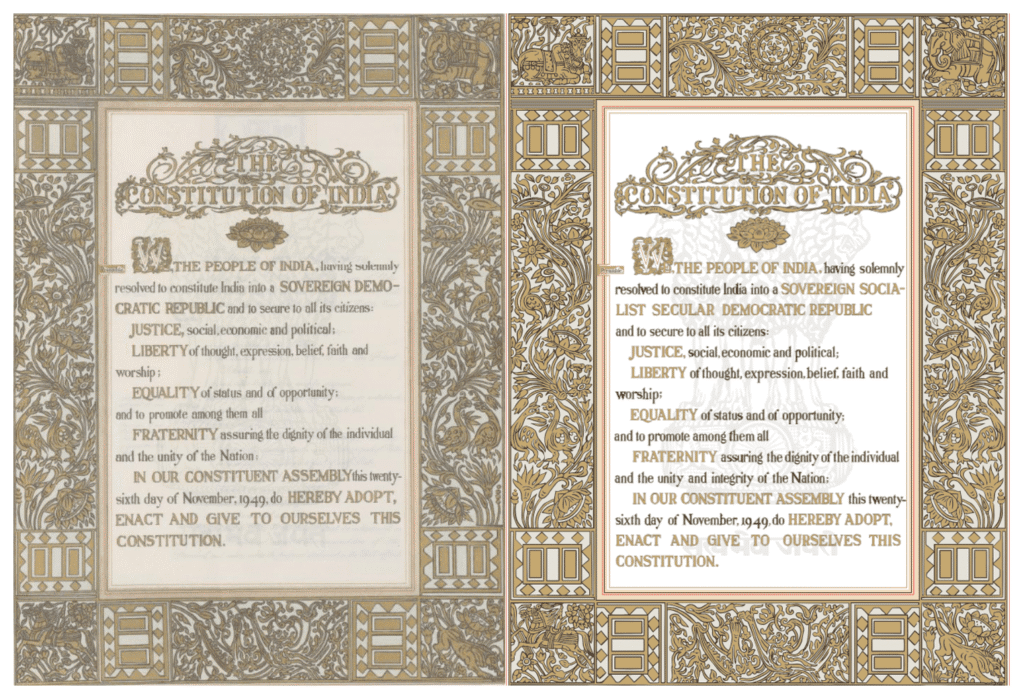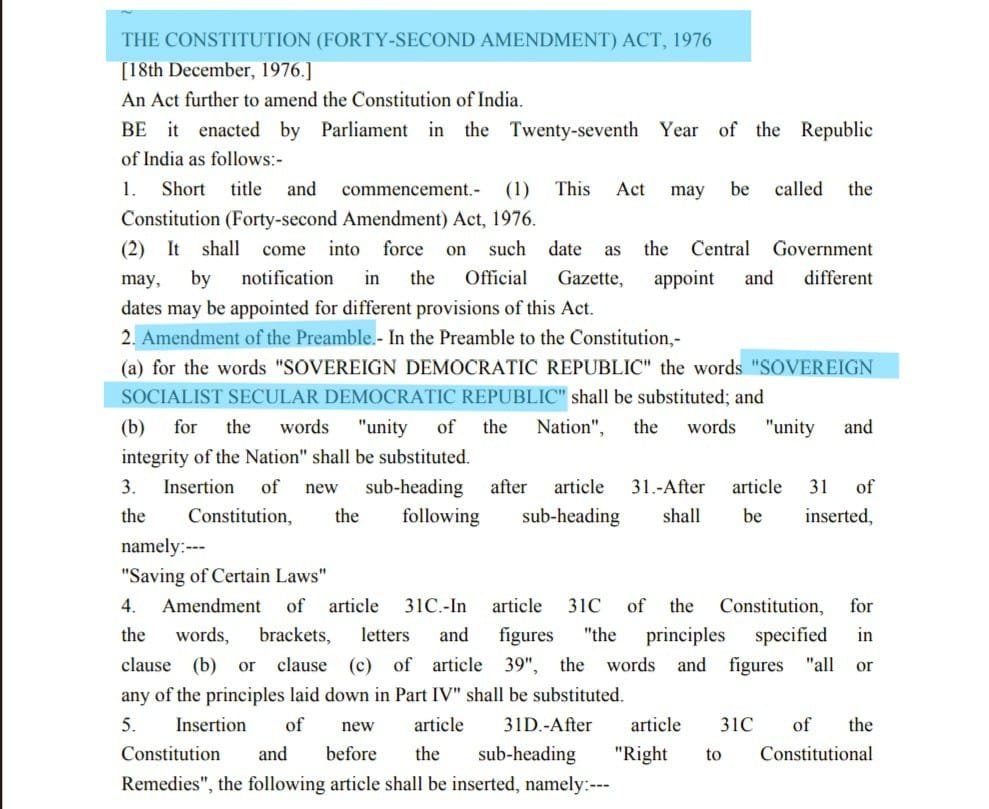In the grand story of India’s democracy, the Constitution is more than just a legal book—it is the soul of the nation. It reflects who we are, what we stand for, and what we aspire to become as a society. And at the heart of this document lies a small yet powerful paragraph—the Preamble.
Recently, two words from this Preamble have returned to the spotlight: “Secular” and “Socialist.” A remark made by the Vice President of India, pointing out that these words were not originally a part of the Preamble, has sparked public debate and discussion. Many are asking—were these values always a part of our Constitution, or were they inserted later? And if they came later, what do they really mean in the Indian context?
To answer this, we need to take a step back in time. Let’s walk through the history of these terms in the Indian Constitution, understand their journey, and explore what they truly represent for the Indian people.

Original Preamble of the Indian Constitution (1950)
On 26 January 1950, the Constitution of India came into force. The Preamble, in its original form, read:
“We, the people of India… give to ourselves this Constitution.”
It described India as a “Sovereign Democratic Republic.”
Notice something? The words “Secular” and “Socialist” were not part of the original Preamble. And yet, India was always meant to be a country that treats all religions equally and aims for social and economic fairness. The absence of these words didn’t mean the absence of the values.
So, why weren’t the words included back then?
What the Framers Believed
To understand this, we turn to the Constituent Assembly Debates, where some of the brightest minds of the time discussed every detail of the Constitution. One of those minds was Dr. B.R. Ambedkar, the principal architect of the Constitution.
Ambedkar was not against the idea of secularism. In fact, he believed that India must be a secular state. But he opposed explicitly writing the word “secular” in the Preamble. His reasoning was simple and profound:
“What is sought to be done in the Constitution is to create a secular state.”
In other words, Ambedkar believed that the spirit of secularism was already built into the Constitution, especially in parts dealing with Fundamental Rights. So, adding the word to the Preamble would be more symbolic than necessary.
Another member, K.T. Shah, proposed including the term “secular,” but the idea was rejected. The majority in the Assembly believed that secularism and socialism were already embedded in the values and provisions of the Constitution.
This approach reflected a broader vision. The framers believed that India’s diversity and its commitment to democracy would naturally promote religious neutrality and social justice. Instead of declaring these terms in the Preamble, they embedded their principles in the operative parts of the Constitution.
The 42nd Amendment: 1976
Fast forward to 1976, a time of political unrest in India. The country was under Emergency, and the then government passed the 42nd Amendment to the Constitution. This amendment added the words “Secular” and “Socialist” to the Preamble, making it read:
“Sovereign Socialist Secular Democratic Republic.”

This change happened during a time when civil liberties were restricted, and democratic institutions faced enormous pressure. Naturally, the timing of this amendment has led to many questioning its political motives.
However, even critics agree that the values themselves were not new. The amendment only put into words what was already part of the Constitution’s soul.
Where Were These Values Already Present?
Let’s explore where secular and socialist ideals were already built into the Constitution long before 1976.
For Secularism:
- Article 25 – Freedom of conscience and the right to practice any religion.
- Article 26 – Freedom to manage religious affairs.
- Article 27 – No taxes to be used for promoting any religion.
- Article 28 – Freedom from religious instruction in educational institutions.
For Socialism (or Social Justice):
- Article 38 – The state shall strive to promote the welfare of the people.
- Article 39 – Ensures equal pay for equal work and the right to an adequate livelihood.
These provisions made it clear that India was committed to religious equality and social fairness right from the start.
The Judiciary Steps In: The Basic Structure Doctrine
While Parliament can amend the Constitution, it cannot change its very foundation. This idea became law in 1973 through the landmark Kesavananda Bharati case.
In this judgment, the Supreme Court introduced the “Basic Structure Doctrine.” It said:
Parliament has wide powers to amend the Constitution, but it cannot destroy or alter its basic structure.
What counts as “basic structure”? The Court didn’t give a fixed list but made it clear that democracy, rule of law, judicial review, and secularism were all part of it.
This means even before the words “secular” and “socialist” were added, the Supreme Court had already recognized them as basic, unchangeable principles.
Key Judgments That Cemented These Values
Minerva Mills v. Union of India (1980)
This case reaffirmed that the basic structure cannot be altered even by constitutional amendments. The court clearly stated that secularism and judicial review are part of the basic structure and must be protected at all costs.
Indra Sawhney Case (1992)
Also known as the Mandal Commission case, this judgment focused on reservations for backward classes. While discussing the role of the state in promoting economic equality, the Court observed that “socialism” is a guiding principle. But it also warned against a rigid interpretation that might block development or entrepreneurship. The idea was to promote democratic socialism—reducing inequality without killing economic freedom.
S.R. Bommai v. Union of India (1994)
This was a turning point for secularism. The Supreme Court ruled that secularism is a core feature of the Constitution. The state must treat all religions with equal respect and neutrality. If a state government acts against secular values, the President can dismiss it under Article 356. This gave secularism teeth—not just an idea, but a principle with legal power.
What Makes Indian Secularism Unique
In many Western countries, secularism means a complete separation of religion and state. But in India, religion is an integral part of public life.
Our version of secularism is based on “Sarva Dharma Sambhava” – equal respect for all religions. This doesn’t mean the state avoids religion entirely. It means the state treats all religions fairly and equally.
The state can intervene in religious matters—for example, to end discrimination, protect public order, or reform harmful practices—but it does so in a way that upholds justice for all.
So, Indian secularism is about balance: allowing religion in public life, but preventing domination or discrimination by any one religion.
The Vice President’s Remark: A Historical Bridge
Let’s return to where this story began—the Vice President’s remark that the words “secular” and “socialist” were not originally in the Preamble, but their spirit is already in the Constitution.
Is he right?
Yes, historically, the words were added only in 1976.
But yes again, because the values were always present—in the Fundamental Rights, in the Directive Principles, and in the Supreme Court’s interpretation.
So, rather than being controversial, the statement serves as a bridge between constitutional history and judicial reality. It reflects a continuity of values that binds India’s past to its present.
But Why the Debate Then?
Even when a statement is factually accurate, it can become political, especially when history, law, and public emotion intersect.
The 42nd Amendment was passed during a difficult time—the Emergency. For many, its changes symbolize an era of suspended freedoms. So, anything related to it—even words added to the Preamble—can feel sensitive or loaded with meaning.
But this is also a reminder: India’s Constitution is a living document. It must be interpreted not just by what’s written but by how it’s understood and applied.
Key Milestones in the Preamble’s Evolution
| Event/Case | Year | What Changed or Affirmed | Significance |
| Original Constitution | 1950 | Preamble read: Sovereign Democratic Republic | No “secular” or “socialist” yet; values present in the structure |
| Kesavananda Bharati | 1973 | Basic Structure Doctrine introduced | Parliament cannot alter fundamental values |
| 42nd Amendment | 1976 | “Secular” and “Socialist” added to Preamble | Symbolic codification during Emergency |
| Minerva Mills | 1980 | Reaffirmed basic structure | Secularism protected |
| Indra Sawhney | 1992 | Affirmed socialism as a guiding principle | Inclusive socialism |
| S.R. Bommai | 1994 | Reaffirmed secularism as a basic feature | Legal protection of secularism |
Conclusion: A Living Spirit of Justice and Equality
The debate about the words “secular” and “socialist” is not just about what’s written in the Preamble, but about what lives in the soul of our Constitution.
The Supreme Court, through landmark judgments, has ensured that these values are protected forever, no matter the political winds or temporary pressures. The Basic Structure Doctrine is our constitutional shield, making sure that India stays true to its founding promise of justice, liberty, equality, and fraternity.
The Vice President’s statement is a chance to look beyond political noise and reconnect with our constitutional roots. It reminds us that understanding our Constitution is the responsibility of every citizen, not just legal experts.
India’s Constitution is not a relic—it’s a living, breathing guide. It carries the dreams of millions and continues to shape the journey of the world’s largest democracy.
🚀 Share your thoughts in the comments!
📢 Share this article with your friends and family to keep them informed!
🔍 Explore More: https://thinkingthorough.com
References
India Today. (2025, June 27). Why debate to drop socialist, secular from Preamble is needless. India Today. https://www.indiatoday.in/india/story/why-debate-to-drop-socialist-secular-from-preamble-of-indian-constitution-is-needless-noise-2747245-2025-06-27
Vishwanath, A. (2025, July 1). What makes the Indian Constitution ‘secular’, even without the word in the Preamble. The Indian Express. https://indianexpress.com/article/explained/explained-law/indias-secular-constitution-even-without-the-word-10098508/
VisionIAS. (2025, January 2). “Socialist”, “Secular” in the preamble | Current Affairs | Vision IAS. Current Affairs | Vision IAS. https://visionias.in/current-affairs/monthly-magazine/2024-12-17/polity-and-governance/socialist-secular-in-the-preamble
Image Credits:
Original Preamble image sourced from Library of Congress, public domain.
Amended Preamble image sourced from Wikipedia, licensed under CC BY-SA 3.0.
Frequently Asked Questions (FAQs) About Socialist, Secular and 42nd Amendment
What is the 42nd Constitutional Amendment?
Passed during the Emergency period (1976), the 42nd Amendment is one of the most extensive amendments to the Constitution. It aimed to strengthen the central government and added key words like "Socialist", "Secular", and "Integrity" to the Preamble.
What is added in the Preamble by the 42nd Amendment?
The 42nd Amendment inserted the words:
"Socialist"
"Secular"
"Integrity"
This changed the Preamble to read: "Sovereign Socialist Secular Democratic Republic" and added "Unity and Integrity of the Nation".
What is meant by Sovereign, Socialist, and Secular?
Sovereign: India is independent and not under the control of any external power.
Socialist: India strives for social and economic equality and works to reduce wealth gaps.
Secular: India has no official religion; the State treats all religions equally and ensures religious freedom.
